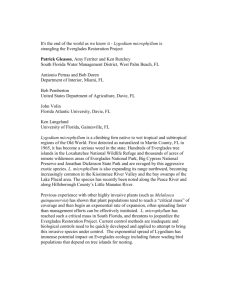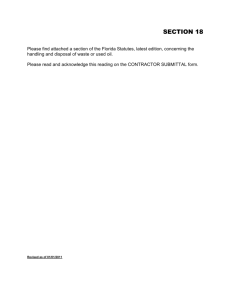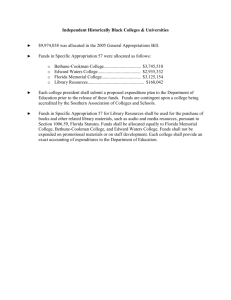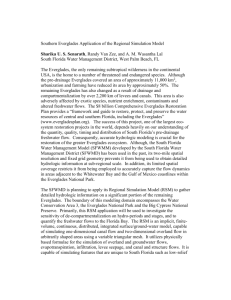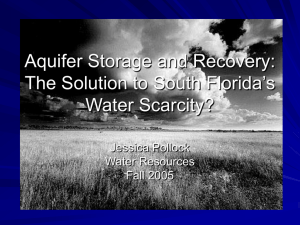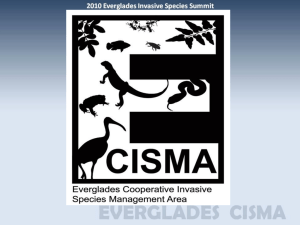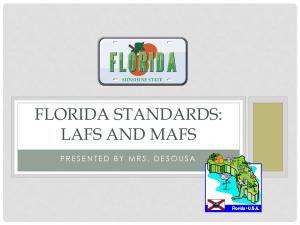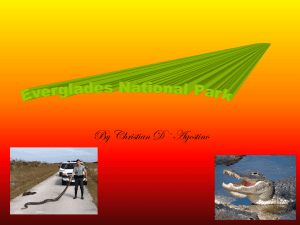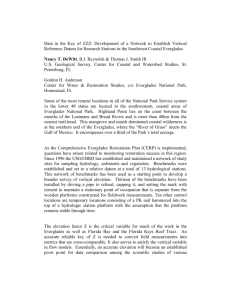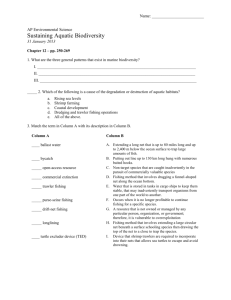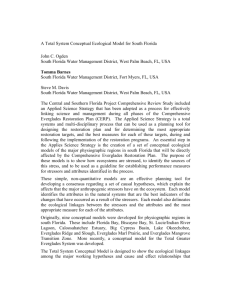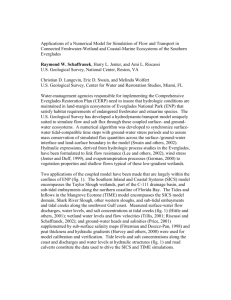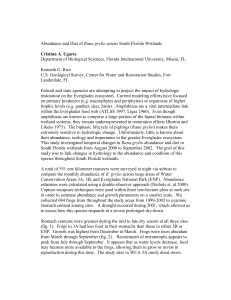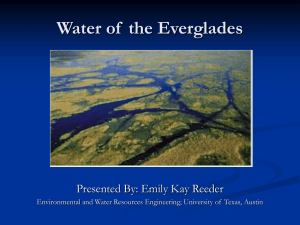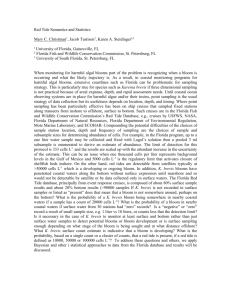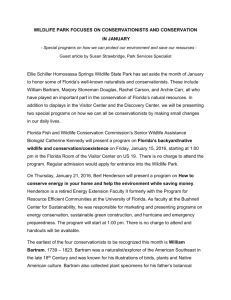Issue of the Quarter 4
advertisement
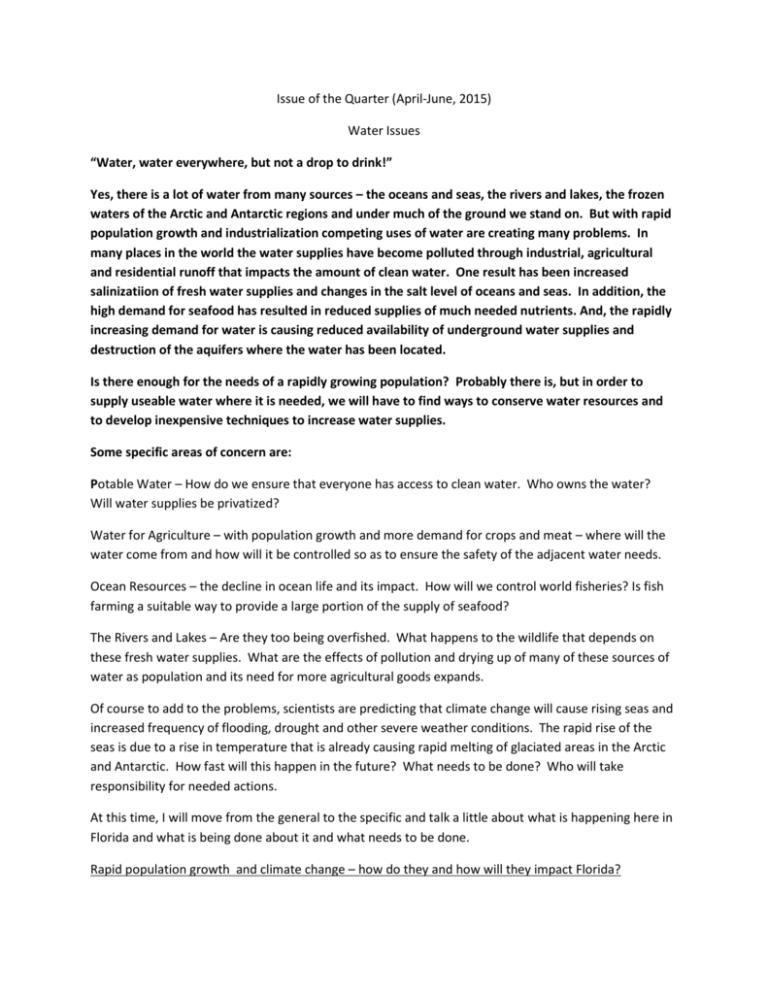
Issue of the Quarter (April-June, 2015) Water Issues “Water, water everywhere, but not a drop to drink!” Yes, there is a lot of water from many sources – the oceans and seas, the rivers and lakes, the frozen waters of the Arctic and Antarctic regions and under much of the ground we stand on. But with rapid population growth and industrialization competing uses of water are creating many problems. In many places in the world the water supplies have become polluted through industrial, agricultural and residential runoff that impacts the amount of clean water. One result has been increased salinizatiion of fresh water supplies and changes in the salt level of oceans and seas. In addition, the high demand for seafood has resulted in reduced supplies of much needed nutrients. And, the rapidly increasing demand for water is causing reduced availability of underground water supplies and destruction of the aquifers where the water has been located. Is there enough for the needs of a rapidly growing population? Probably there is, but in order to supply useable water where it is needed, we will have to find ways to conserve water resources and to develop inexpensive techniques to increase water supplies. Some specific areas of concern are: Potable Water – How do we ensure that everyone has access to clean water. Who owns the water? Will water supplies be privatized? Water for Agriculture – with population growth and more demand for crops and meat – where will the water come from and how will it be controlled so as to ensure the safety of the adjacent water needs. Ocean Resources – the decline in ocean life and its impact. How will we control world fisheries? Is fish farming a suitable way to provide a large portion of the supply of seafood? The Rivers and Lakes – Are they too being overfished. What happens to the wildlife that depends on these fresh water supplies. What are the effects of pollution and drying up of many of these sources of water as population and its need for more agricultural goods expands. Of course to add to the problems, scientists are predicting that climate change will cause rising seas and increased frequency of flooding, drought and other severe weather conditions. The rapid rise of the seas is due to a rise in temperature that is already causing rapid melting of glaciated areas in the Arctic and Antarctic. How fast will this happen in the future? What needs to be done? Who will take responsibility for needed actions. At this time, I will move from the general to the specific and talk a little about what is happening here in Florida and what is being done about it and what needs to be done. Rapid population growth and climate change – how do they and how will they impact Florida? We are already seeing some of the impact associated with Florida’s rapid population growth and climate change. The underground sources of water are in grave danger in Southeastern and in other areas of the state. In the southeast where the Biscayne aquifer is the main source of drinking water, salt water has already intruded into the system. Rising sea levels increase the backpressure on coastal aquifers, reduce groundwater flow toward the ocean and cause the saltwater front to move inland, thus threatening to contaminate water-supply wells in coastal areas. Also in the southernmost Everglades, sea-level rise will cause brackish waters to encroach further. In our area, underground water supplies are endangered by overuse and the aquifer is in grave danger. In other parts of Florida, underground streams have dried up and brackish water has replaced the pristine water in many of the famous springs. Of course, Lake Okeechobee and the Everglades have long been a major concern for South Florida, not only because they were a major source of water supplies but also because the Everglades, in particular, are a unique biological area and an important habitat for wildlife. Some time ago, investors found that much of the area was also suitable for raising citrus trees, sugar and tomatoes and they bought up huge chunks of land. Unfortunately, the runoff from their activities turned the lake into a sewer which in turn caused drastic changes to the Everglades as well. To curb these activities, the Federal and State governments stepped in to place controls on the activities which led to great reductions in pollution. However, there continues to be a lot of conflict between the growers and the conservationists as well as residents of affected areas. The growers spend huge amounts of money lobbying state legislators in order to protect their interests often at the expense of citizens who live in the area and conservation in general. Another major area of concern in the state is the amount of money the state budgets for conservation of our natural habitat. Because many people felt the State was not doing enough, citizens of the state got Amendment 1 placed on last years ballot. This amendment called for a definite amount to be set aside for these purposes in future state budgets. Seventy five percent of the voters approved the amendment. Now the legislature is fine tuning the budget and finding ways to fund other activities that are not directly related to the intention of the amendment from the money that must be set aside. There are many other areas that demand our attention as concerned citizens such as the impact of phosphate mining, the possible impact of opening our coastal waters to drilling for oil and gas, the existence of many sink holes in parts of the state, and the possibility of fracking if petroleum and gas engineers feel a need for it, etc. etc What can we, as individuals, do. Political action: We can call and/or write to our legislators to ensure that they are aware of the problems and tell them to take actions to resolve them. And we must be willing to help candidates that will take action and oppose those who will not. Education: We can educate ourselves on what is happening (you can find a lot on the net – also, I highly recommend you read an article in the February 2015 issue of National Geographic Magazine called Treading Water which talks about climate change and how it may impact Florida). Individual Actions: We can take steps to reduce consumption of water and to protect our environment. For some ideas see “Earth Day 2011: Sacred Waters” (copies are available on the information table). Al Usack for the Social Just Committee of MUUF

